CES
Tech
January 10, 2023
The Hidden Gems of CES 2023
As America’s biggest tech conference comes to a close, here’s our take on the emerging tech to watch. While not yet fully mature, these products are poised to power the next wave of digital experience.
Words by Huge staff
From connected scooters to smart toilets, there’s no end to the gadget hype generated by CES 2023. Once we bypassed all the noise, we discovered several early-to mid-stage innovations that can truly change how we interact with technology. While not yet fully mature, these products are poised to power the next wave of digital experience.
Here are five hidden gems unveiled at CES that feel like the future.
Withings U-Scan | Tech you can pee on
The French consumer electronics company Withings unveiled a rather unusual bit of technology to its suite of health and fitness tracking products.
Its connected urine analysis device, U-Scan, is essentially a mini lab that sits in your toilet and reports back on your metabolic functions. It features a sensor that detects and retrieves urine, which it passes to a miniature chemical test in a replaceable cartridge. Results are then uploaded into the Withings app, with insights and trends based on prior sample results.
At first pass, the technology seems ridiculous, but once you get past that it’s actually a rather clever device that might appeal to fitness enthusiasts or anyone managing a health condition that requires urinalysis. Daily or weekly assessments can help consumers get better health insights about how their behavior affects their metabolic health.
Withings first gained attention introducing connected digital scales to market in 2009, and has since added a number of devices over the years including a connected thermometer, blood pressure monitor, and sleep analyzer. The U-Scan is the next logical step, and signals progress in the overall market.
Currently, heart rate sensors dominate the market via wearable tech such as the Apple Watch, Google’s Fitbit, and Samsung’s Galaxy watch, each of which provide real-time data analytics. But this shift from fitness into medical testing gained momentum during the pandemic, and will expand to other common healthcare services in the coming years.
Despite the epic failure of Theranos, the discredited blood-testing startup, there’s real value in putting consumers more directly in control of their data. Think forward several years and you can see how sensor technologies could start to build a “digital twin,” creating a full, real-time picture of a person’s health and fitness.
— Jon Hackett, Group Technology Director
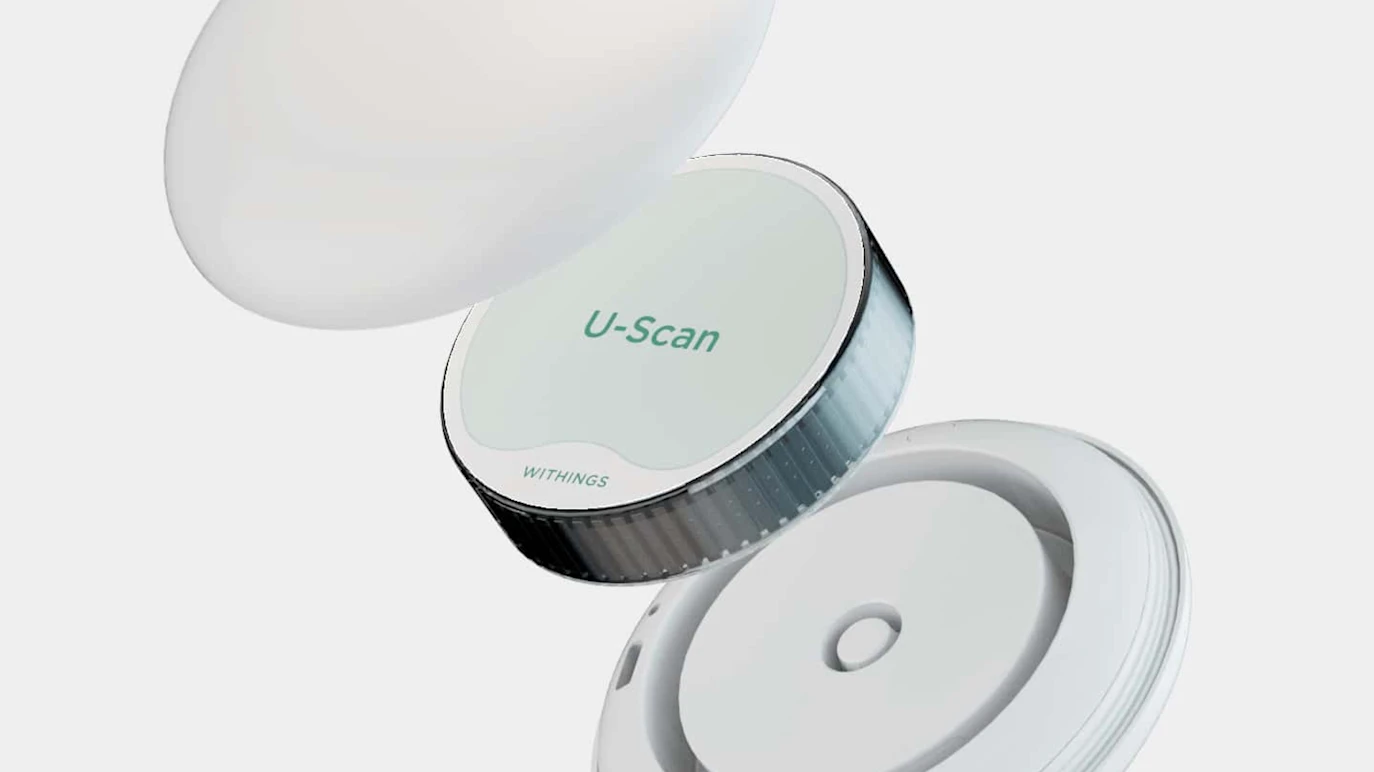
Withings U-scan. Photo courtesy Withings
Magic Leap 2 | Baby-stepping into borderless
While the potential for innovation in Web3 and the virtual space is as vast as ever, a broad consumer market to support existing AR/MR tech (outside of gaming) has yet to manifest at scale. As a result, many companies at CES exhibited a deliberate intent to become viable in existing markets.
Notably, Magic Leap, an early innovator in AR accessories, has shifted the focus of its latest device, Magic Leap 2 (ML2), to serve enterprise clients rather than the consumer market. Demos included experiences in safety training, medical data visualization and architectural design. The examples drew attention to precision, versatility, and clarity. ML2 boasts high resolution and adaptable optics, but the visual experiences didn’t really ‘wow’ me. Instead, the more interesting feature was the headset’s dynamic dimming. By activating either segmented or global dimming, the user can choose to focus a tint mask on the activated space or block environmental light completely, allowing operation in any light without loss of clarity. The device also allows for collaboration in real time across time zones, potentially making it an exciting tool for the future of work as well as opening doors to new collective experiences.
Another notable difference: comfort and fit. After a day spent trying on front-heavy or otherwise awkward headsets, removing the ML2 off my face prompted no sense of relief. The ergonomic headset is noticeably lightweight and comfortable, designed for longer duration enterprise applications. (It also claims to reduce eye strain with constant eye tracking and content rendering, but this wasn’t apparent in our short demo.)
While visuals aren’t refined enough to transport the wearer out of their reality, applications in data visualization, navigation, product experience, or education give Magic Leap a stronger raison d’être and demonstrate the company’s potential to adapt their technology and meet future use cases.
We’re building borderless brand worlds at Huge, and I’m as eager as anyone to finally get my hands on a device that delivers a more natural immersive digital experience. The Magic Leap may have a way to go, but at least it seems to know where it’s going.
— Sam Wheeler, Creative Director, Experience Innovation
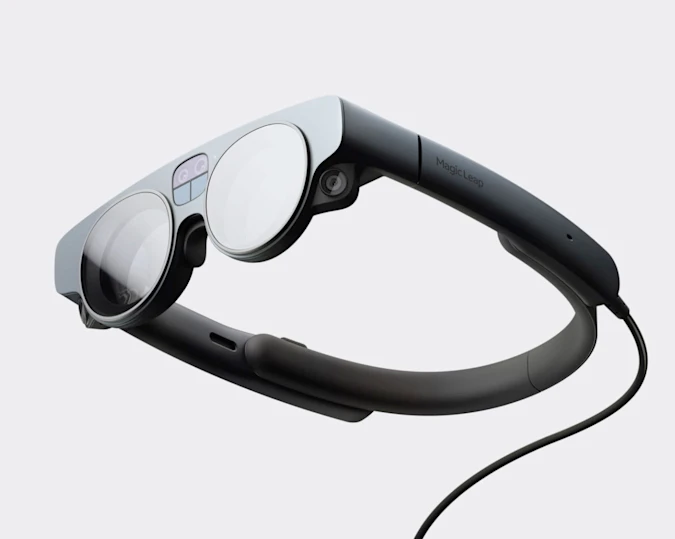
The Magic Leap 2 headset, photo courtesy Magic Leap.
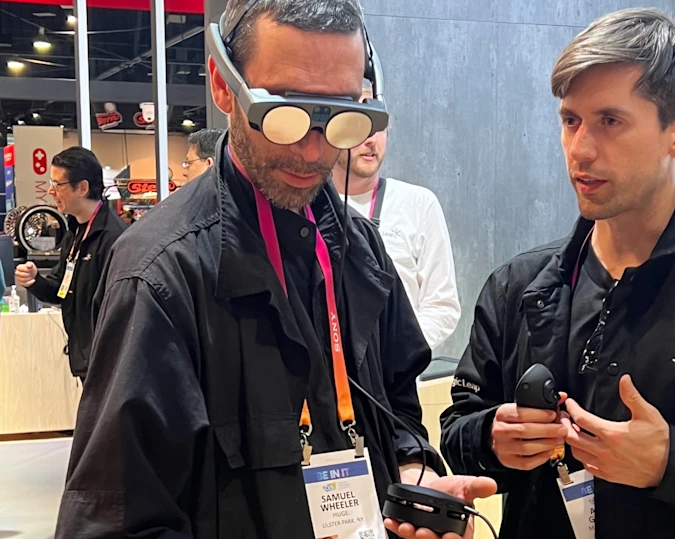
Huge’s Sam Wheeler tests the new headset.
Dimension X | Code-free 3D world building
Dimension X developers are working on a new platform that could remove two major barriers to 3D: the need for coding expertise and cross-device application.
The editor (or creator) software, which is so new it wasn’t fully demoed at the convention, purports to let people build 3D worlds using intelligent 3D assets called “sparks.” The final output, what Dimension X is calling a “book,” essentially is a sharable collection of drag-and-drop assets that others can view across mobile, web, AR, VR, or even in person, with optimized asset weights for each platform.
“It’s taking that Roblox, Minecraft thing to the next level,” Chief Technology Officer Kyle Ringgenberg told me. “A world is great, but at the end of the day, you build a cool world and you sit around and look at your friend and think: so what?”
Dimension X has a default library of assets, but a pipeline lets creators bring in elements from anywhere. For both brands and creators, this could enable faster executions without the need for development resources. The company’s proprietary software developer kit (SDK) also allows for novel and custom updates that many brands might find appealing.
Though this is clearly early-stage development, these entrepreneurs have rightly identified an emerging market need for 3D that doesn’t require deep expertise in tools like Blender, Unity, or Unreal Engine. There are myriad applications for this kind of tool, including immersive education, corporate training, gaming, and all kinds of customer engagement. The founders envision their customer base as everyone from individual users to educators to large corporations.
“The company started in the education space,” says Ringgenberg. “Imagine experiencing historical events. Build a book that showcases a historical event. The opposite side of that is letting the students build things … that’s a huge part of where we’re going.”
To view the experience, you’ll currently need the Dimension X player to open it. But down the road, that player could simply be a wrapper deployed in any number of environments. Could this become the Squarespace of 3D experiences? The platform is launching at the Game Developers Conference (GCD) in March. Keep it on your radar.
— Emily Wengert, MD, ECD Experience Innovation
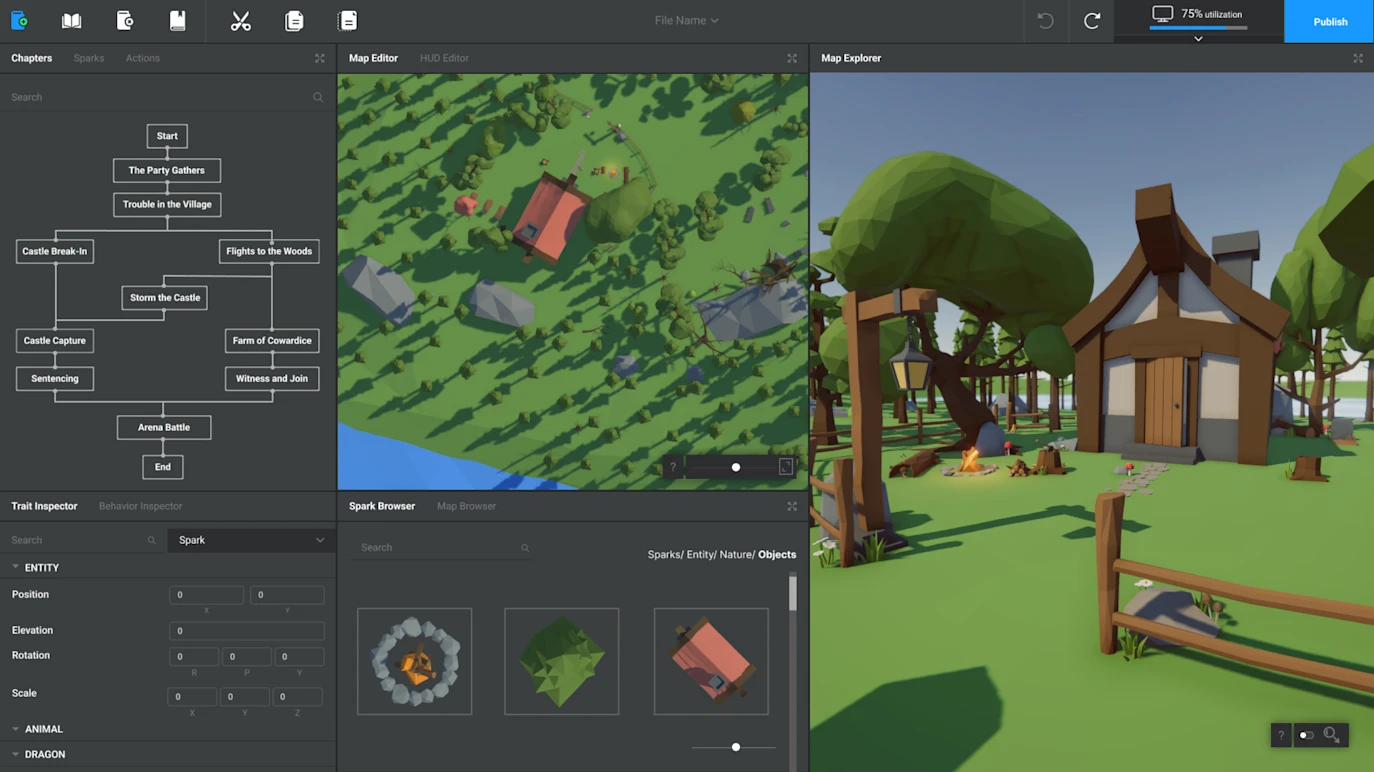
Dimension X’s Bonfire preview. Photo courtesy Dimension X
UltraLeap | Virtual, scalable touch screens
UltraLeap’s gestural technology capitalizes on post-pandemic demands for sanitary interfaces in a touchscreen world. There’s always been a trade-off between hygiene, kiosks, and mobile screens. UltraLeap is propelling touchless technology forward with its new 3Di hand tracking camera and application, which detects real-time hand movement and converts it into an on-screen cursor.
While these tools enable quick, transactional tasks like ordering from a kiosk or checking into a hotel, they might also inspire experience-led design features that meaningfully increase customer interaction for brands.
UltraLeap has already piloted gestural ordering with PepsiCo and KFC, and helped LEGO create “touchless tactile” campaigns to explore the world of new products at physical retail stores. The ability for the tool to enhance rather than replace current experiences will be key to its success in the market.
Designing CX journeys and physical-digital spaces has led Huge to test and iterate with gestural prototypes in flagship experiences for years. This is, pardon the pun, a leap forward. With simple, scalable installations to meet today’s consumer demand, you’ll be seeing (and gesturing) more often in coming years, in everything from fashion retail and hospitality to large-scale live events.
— Katie Birkel, Vice President of Strategic Growth
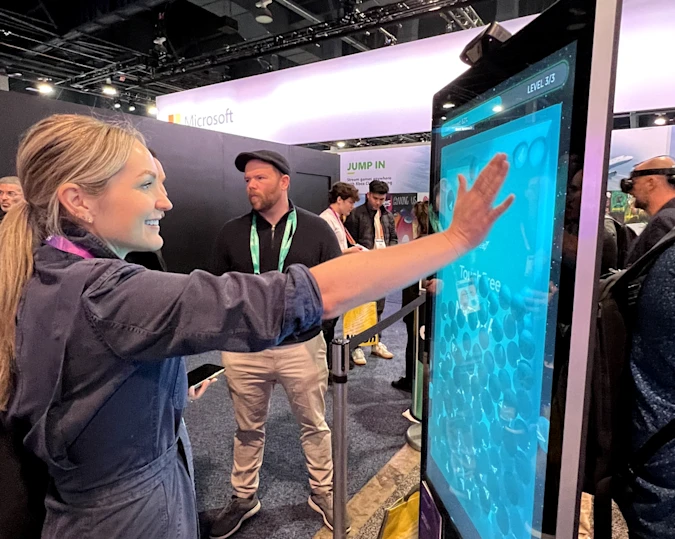
Huge’s Katie Birkel tests Mid-air haptics at CES.
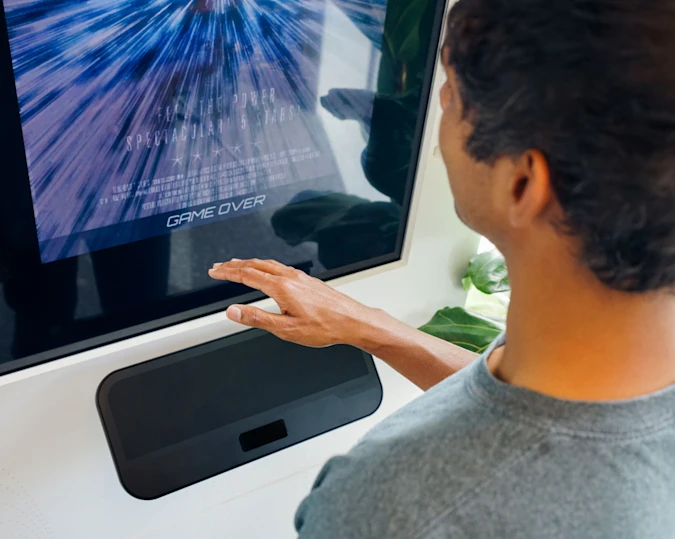
Photo courtesy UltraLeap
ION3 | Scent is now digital, wearable, and wireless
As brands think about how to integrate scent into their content, an under-the-radar digital scent pioneer has done it for them. With a new tool that can create unique digital aromas backed by neuroscience, OVR Technology appears suddenly at the forefront of olfactory experience design.
While audio and visual leaps are being made across the digital landscape, particularly for XR and the metaverse, scent remains largely untapped, despite its potential to create a more emotional, immersive, realistic experience for people. OVR set out to solve this problem by introducing the ION3, which it claims is the first wearable technology that allows users to experience scent in the digital realm.
During an immersive VR demo, it was remarkable how transportive the effects of ION3 could be, leveraging both spatial and positional factors to mimic lifelike aromas of familiar foods, environments, and natural elements. For example, I stood in front of marshmallows roasting on a crackling campfire, smelling woodsy smoke and sweet vanilla. On mobile, the meditation demo smelled like green grass, rain, and floral notes to round out the tropical vibe.
OVR plans to operate on a subscription model that allows users to create “scent memories” through immersive content within the OVR Scent Studio, a free application that comes with every ION3 device. With a “scentware cartridge,” users can create their own digitally native aromas and combine them with other media like video and audio to create an original experience. OVR also provides technology solutions for brand activations, such as retail pop-ups, branded digital content, or location-specific storytelling experiences. Essentially, they’re enabling developers to add scent to any project, just like they were adding spatial audio.
OVR is tapping into a primal sense through the use of 4D multi-sensory tools. In the pursuit of creating premium, measurable, and meaningful XR experiences for our clients, it’s products like these that open up new paths to innovation in 2023 and beyond.
— Natalie Comins, Group Creative Director, Experience Innovation
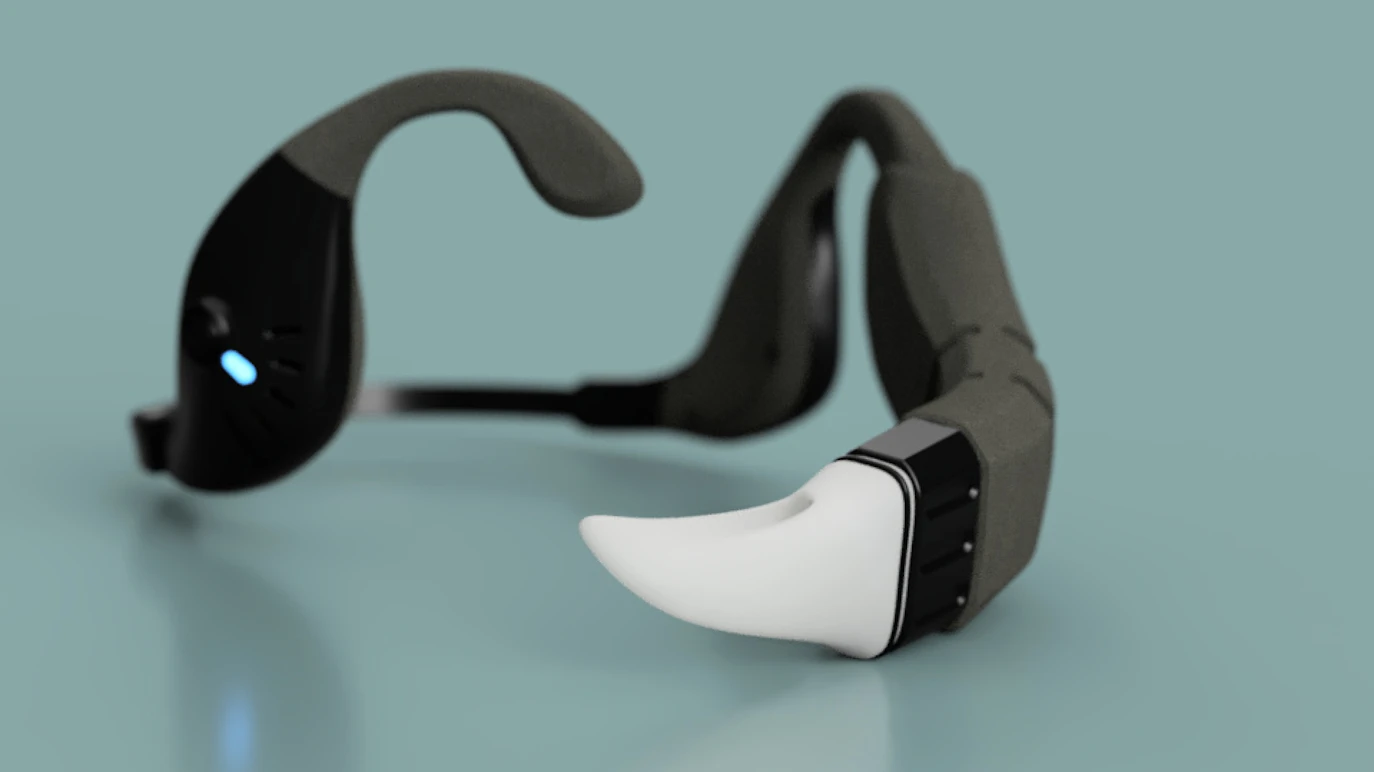
ION3 by OVR Technology
